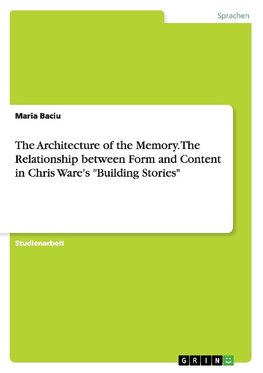
-
 Nemecký jazyk
Nemecký jazyk
The Architecture of the Memory. The Relationship between Form and Content in Chris Ware's "Building Stories"
Autor: Maria Baciu
Studienarbeit aus dem Jahr 2015 im Fachbereich Literaturwissenschaft - Moderne Literatur, Note: 1, Ludwig-Maximilians-Universität München (Institut für Anglistik und Amerikanistik), Veranstaltung: Breaking the Form: Books Striving not to be Books, Sprache:... Viac o knihe
Na objednávku, dodanie 2-4 týždne
16.65 €
bežná cena: 18.50 €
O knihe
Studienarbeit aus dem Jahr 2015 im Fachbereich Literaturwissenschaft - Moderne Literatur, Note: 1, Ludwig-Maximilians-Universität München (Institut für Anglistik und Amerikanistik), Veranstaltung: Breaking the Form: Books Striving not to be Books, Sprache: Deutsch, Abstract: The aim of this paper is to provide an analysis of the "architecture" that Chris Ware employs on every level of the story. Drawn from Ware's statement that "the metaphor of architecture runs through our brains" and that "there's something about the way the mind and the way buildings are structured that are [sic] analogous" (Paulson), the present analysis illustrates this analogy by looking at both the personal and the spatial dimension of this architectural product.
On the one hand, the reader is presented a skilful architecture of the mind and feelings of the main character, along with the multiple dimensions of the character's memory. In the respective architecture, the spatial dimension of the building plays a crucial role, since it represents a frame for the main plot: "the history of a building and the things that have happened within it [...] like a living organism through time." At the same time, the character is framed by the architecture of the building in that it represents a "self-conscious creative construction on the part of the woman to write for her creative writing class". (Millman)
The paper will also look at how form is employed to convey content, both in terms of the organization of panels and frames, on the macro-level, and of visual/narrative perspective, monolog and dialog, on the micro-level. The way in which these elements are combined - starting with straightforward manners and ending up to mnemonically complex ones - demands that the reader interpret them, based on "common experience and a history of observation". (Eisner, 2006, 24) The paper's chapters are structured according to the steps followed when building a house: the design, laying the foundation, building the walls, installing the roof, and finally, painting the walls. These steps are not exclusively related to the building as such, but rather to the entire "architecture" of the story".
- Vydavateľstvo: GRIN Verlag
- Rok vydania: 2015
- Formát: Paperback
- Rozmer: 210 x 148 mm
- Jazyk: Nemecký jazyk
- ISBN: 9783668080270



 Anglický jazyk
Anglický jazyk 

 Ruský jazyk
Ruský jazyk 




